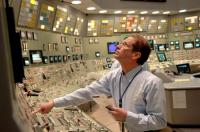ALL BOARD OPERATORS ARE CONTROL FREAKS
I was dreaming of the past and my heart was beating fast...
I began to lose control... I began to lose control...
("Jealous Guy," by the great poet John Lennon, 1971)
THE FIRST CONTROL ROOMS
PTOA Readers and Students already know that "local control" means the outside Process Operator makes changes to the process to keep it within the desired operating range. The control hardware is located out in the processing area with all the pumps and pipes.
The first local controllers used throttled air pressure signals (pneumatic signals) and... in today's high-tech world... look like a complicated Rube Goldberg machine inside; lots of linkages and movements that provided limited automated control of the processes.
The first pneumatic indicating, recording, and controlling instruments were physically much bigger than the instruments shown in the previous PTOA segment.
Nowadays, there is not much local controlling done by outside Process Operators.
The pneumatic transmitter (works with air pressure signals) was the game changer that made centralized process control in a Control Room "the way to go."
This technological advance made it possible keep the functions of measuring and transmitting process temperatures in the processing area while centralizing the controlling, indicating and recording functions into an area that could be located the length of a football field or hundreds of meters away from the processing area.
Plant Owners and Corporate HQ administrators quickly upgraded to centralizing process control because centralizing control reduced the number of Process Operators on the payroll.
But the primary driving force for centralizing control of process operations was that this advance in automation technology made the plant processes stay at desired operating ranges better than a human being could do...that is, at least the vast majority of the time.
Voila!...
The "Control Room" and "Control Board/Control Panel" came to be.
THE CONTROL BOARD OPERATOR
The job description for a "Control Board Operator" likewise evolved into existence.
Advances in automated control technology changed the job description of the former Process Operator into a Control Board Operator that was enabled to understand how more than one part of one plant in a processing complex upgraded its feedstock(s) into desired product(s).
From the vantage point of a seat at the Control Board Panel, it was now possible for the Control Board Operator to understand how multiple processing plants in the complex interacted with each other.
For example, in a very complex and integrated processing facility like a fuels or petrochemical refinery, each individual plant in the complex has unique criteria for making the best final product. In that case, the Control Board Operator must understand how to use automated technology to optimize production of the best slate of overall desired products.
And, of course, the modern Process Operator had to be fluent in reading plant schematics, PFDs and P&IDs.
Additionally and perhaps most importantly, Control Board Operators must be proficient understanding the limitations of process automation. From time to time, the collective process data received from all instruments will not appear to be in sync.
During those times, the Control Board Operator needs to override the automation and re-establish "manual control" to return the process to safe and efficient operations.
THE FOUR MAIN PROCESS VARIABLES:
TEMPERATURE, PRESSURE,
FLOWRATE and LEVEL
Up to this point, the PTOA has been focussing on Temperature and how this parameter can change during processing.
Temperature is one of four "Process Variables" that must be controlled to churn out desired products. The other process variables are Pressure, process stream Flowrate, and container Levels.
Other Process Variables do exist but are specific to a particular processing plant. Yet every processing plant must control Temperature, Pressure, Flowrate, and Level. For this reason, The PTOA will limit its focus to understanding the four main Process Variables.
All Control Board Operators spend their entire shift keeping the Temperatures, Pressures, process stream Flowrates, and container Levels (the 4 main Process Variables) where they must be to make final products safely and efficiently.
All Control Board Operators are control freaks.
Take Home Messages: The invention of the pneumatic transmitter (works with air pressure signals) separated the sensing and transmitting control hardware located in the processing area from the controlling, indicating, and recording instruments located in a centralized area away from the processing area.
Otherwise stated, the invention of the pneumatic controller also created Control Rooms, Control Board Panels, and Control Board Operators.
All Control Board Operators spend their shifts controlling the main Process Variables: Temperature, Pressure, Flowrates, and Levels. Control Board Operators must understand the process and the instrumentation competently so they know when automatic control must be overridden and return the process to manual control for safe and efficient operations.
©2015 PTOA Segment 00009
Process Industry Automation
You need to login or register to bookmark/favorite this content.

